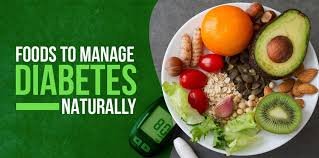Diabetes is a chronic condition that affects millions of people worldwide. While medications and insulin are essential for many, managing diabetes naturally with diet and exercise can significantly improve blood sugar control and enhance overall health. Adopting a Natural diabetes management diet and incorporating regular physical activity into your routine can help prevent complications and improve your quality of life.
In this article, we’ll explore how to manage diabetes naturally, focusing on diet and exercise as the primary tools. We’ll discuss the best foods to include, the types of exercise that can help control blood sugar, and tips for adopting a holistic diabetes care approach.
Why Managing Diabetes Naturally with Diet and Exercise Is Important
Before we dive into the specifics, it’s essential to understand the connection between diet, exercise, and diabetes. Proper management can help you control your blood sugar, reduce the risk of complications, and prevent the need for medication. Both diet and exercise play a critical role in:
- Balancing blood sugar levels: Healthy eating and physical activity can help stabilize glucose levels throughout the day.
- Maintaining a healthy weight: Both diet and exercise can prevent excessive weight gain, which is a major risk factor for type 2 diabetes.
- Improving insulin sensitivity: Regular exercise helps the body use insulin more effectively, making it easier to control blood sugar.
- Reducing inflammation: A healthy diet and regular exercise can lower inflammation in the body, which is often elevated in people with diabetes. diet and exercise
A Natural Diabetes Management Diet
The foods you eat can have a significant impact on your blood sugar levels. A Natural diabetes management diet focuses on whole, nutrient-dense foods that help regulate blood sugar and prevent spikes. Here’s how you can structure your diet to manage diabetes naturally:
1. Focus on Low Glycemic Index (GI) Foods
The glycemic index measures how quickly a food raises your blood sugar. Foods with a low GI are digested more slowly, leading to gradual increases in blood sugar. Incorporating these foods into your diet can help you avoid sharp spikes in glucose levels.
Low-GI Foods to Include:
- Whole grains (brown rice, quinoa, barley)
- Non-starchy vegetables (spinach, kale, cucumbers)
- Legumes (lentils, beans, chickpeas)
- Fruits like berries, apples, and pears
- diet and exercise
2. Choose Healthy Fats
Not all fats are created equal. Healthy fats can improve insulin sensitivity and help control blood sugar. Opt for unsaturated fats, such as those found in:
- Avocados
- Nuts and seeds (almonds, chia seeds)
- Olive oil and coconut oil
- Fatty fish (salmon, mackerel, sardines)
- diet and exercise
3. Incorporate Fiber-Rich Foods
Fiber helps slow down the absorption of sugar into the bloodstream, preventing spikes in blood glucose levels. Eating fiber-rich foods can also improve digestion and promote a feeling of fullness, which can help with weight management.
High-Fiber Foods to Include:
- Vegetables (broccoli, Brussels sprouts, carrots)
- Fruits (apples, pears, berries)
- Whole grains (oats, whole wheat, brown rice)
- Legumes (beans, lentils)
4. Limit Refined Carbohydrates and Sugars
Refined carbs and sugars cause rapid increases in blood sugar levels, making it harder to manage diabetes. Try to limit foods like:
- White bread, pastries, and other processed foods
- Sugary beverages (sodas, sweetened juices)
- Sweets and candy
5. Prioritize Protein
Protein helps keep you full longer and supports muscle maintenance. It also plays a role in regulating blood sugar levels. Include lean protein sources such as:
- Chicken, turkey, and lean cuts of beef
- Fish and seafood
- Eggs
- Plant-based proteins (tofu, tempeh, edamame)
Exercise for Blood Sugar Control
Physical activity is a powerful tool in managing diabetes. Exercise for blood sugar control helps lower blood sugar levels by increasing insulin sensitivity and promoting the efficient use of glucose by muscles. Regular exercise also supports weight loss, heart health, and overall well-being.
Types of Exercise to Incorporate into Your Routine
Different types of exercise can have varying benefits for blood sugar control. Here are some of the best forms of exercise for people with diabetes:
1. Aerobic Exercise (Cardio)
Aerobic exercise helps improve heart health and lowers blood sugar levels by increasing the body’s ability to use insulin. Activities like walking, jogging, swimming, and cycling can help you maintain steady blood sugar levels.
Recommended Aerobic Exercises:
- Walking (aim for 30 minutes per day)
- Cycling (stationary or outdoor)
- Swimming or water aerobics
- Dancing or group fitness classes
2. Strength Training
Strength training, or resistance exercises, helps build muscle mass, which in turn increases your resting metabolic rate and improves insulin sensitivity. It also aids in weight management, a critical factor in managing diabetes.
Recommended Strength Training Exercises:
- Weightlifting or using resistance bands
- Bodyweight exercises (squats, lunges, push-ups)
- Pilates or yoga (which also improve flexibility)
3. Flexibility and Balance Exercises
While not directly related to blood sugar control, flexibility and balance exercises such as yoga and stretching can enhance mobility, reduce stress, and improve overall well-being. Reducing stress is crucial for managing blood sugar, as stress can cause spikes in glucose levels.
Recommended Flexibility Exercises:
- Yoga or Tai Chi
- Stretching routines
- Pilates
4. High-Intensity Interval Training (HIIT)
HIIT involves alternating between short bursts of intense activity and periods of rest. Research shows that HIIT can improve insulin sensitivity, help with weight loss, and lower blood sugar levels. However, it’s important to consult your healthcare provider before starting HIIT, especially if you have other health conditions.
Recommended HIIT Exercises:
- Short bursts of sprinting
- Jump rope intervals
- Interval cycling
Holistic Diabetes Care: A Complete Approach
A holistic diabetes care approach goes beyond just diet and exercise. It emphasizes the importance of mental, emotional, and social well-being in managing diabetes. By incorporating other healthy lifestyle habits, you can improve your overall quality of life while managing your condition more effectively.
Key Elements of Holistic Diabetes Care:
- Stress Management: Chronic stress can elevate blood sugar levels, so finding effective ways to manage stress is crucial. Practices like meditation, mindfulness, and deep-breathing exercises can help.
- Sleep Quality: Poor sleep can negatively affect blood sugar control. Aim for 7-9 hours of quality sleep each night to help regulate glucose metabolism.
- Regular Monitoring: Keeping track of your blood sugar levels regularly helps you understand how your diet and exercise affect your glucose control. Consider using a blood glucose meter to monitor your progress.
- Support Systems: Connecting with other people who understand your condition can provide emotional support. Consider joining a diabetes support group, either in person or online.
Sample Day of Eating for Managing Diabetes Naturally
Here’s an example of a daily meal plan that aligns with a Natural diabetes management diet:
| Meal | Food |
|---|---|
| Breakfast | Scrambled eggs with spinach and tomatoes, whole-grain toast |
| Snack | Apple with a handful of almonds |
| Lunch | Grilled chicken salad with leafy greens, avocado, and olive oil |
| Snack | Carrot sticks with hummus |
| Dinner | Baked salmon, quinoa, and steamed broccoli |
| Dessert | Berries with Greek yogurt |
FAQs on Managing Diabetes Naturally with Diet and Exercise
1. Can exercise really lower blood sugar levels?
Yes, exercise helps improve insulin sensitivity and allows muscles to use glucose more efficiently, which can lower blood sugar levels.
2. How much exercise should I get to control my blood sugar?
Aim for at least 150 minutes of moderate-intensity aerobic activity or 75 minutes of vigorous-intensity exercise per week. Include strength training at least twice a week.
3. What foods should I avoid if I have diabetes?
Avoid refined carbohydrates, sugary foods, and processed snacks. Focus on whole grains, lean proteins, healthy fats, and plenty of fruits and vegetables.
4. Can stress affect my blood sugar levels?
Yes, stress can increase blood sugar levels by triggering the release of hormones like cortisol, which can interfere with insulin function.
5. How do I get started with a diabetes-friendly diet?
Start by reducing your intake of sugary foods and processed carbs. Focus on whole, nutrient-dense foods like vegetables, lean proteins, healthy fats, and whole grains.
Conclusion
Managing diabetes naturally with diet and exercise is a powerful and effective way to control blood sugar levels and reduce the risk of complications. By following a Natural diabetes management diet and incorporating regular physical activity into your routine, you can significantly improve your health and well-being. Additionally, adopting a holistic diabetes care approach can help you achieve long-term success in managing your condition.
Start small, stay consistent, and consult with your healthcare provider to ensure you’re on the right track. Your efforts will lead to better blood sugar control and a healthier lifestyle overall.





